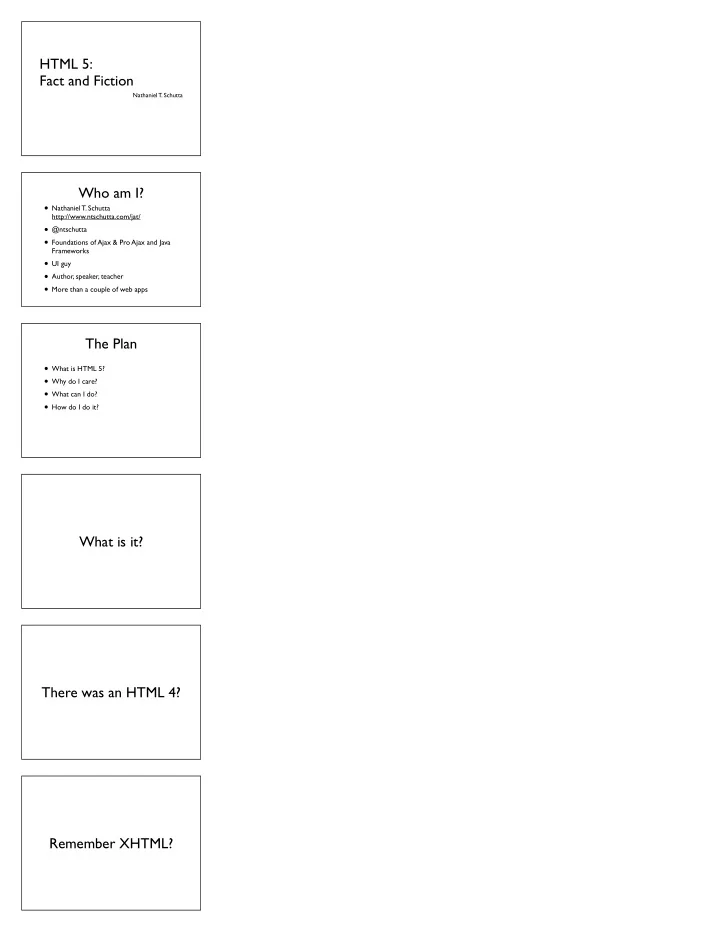

HTML 5: Fact and Fiction Nathaniel T. Schutta Who am I? • Nathaniel T. Schutta http://www.ntschutta.com/jat/ • @ntschutta • Foundations of Ajax & Pro Ajax and Java Frameworks • UI guy • Author, speaker, teacher • More than a couple of web apps The Plan • What is HTML 5? • Why do I care? • What can I do? • How do I do it? What is it? There was an HTML 4? Remember XHTML?
What happened there? Lack of features. Well-formed issue. Browsers are forgiving. Web flourished because of it. Lots of “broken” pages.
Draconian error handling. Not backwards compatible. MIME type largely ignored. Syntax was adopted. Lower case tags, double quotes, closing slashes. Very few pages are parsed as XHTML.
HTML little long in the tooth... And wasn’t designed for applications. Pushing boundaries. De facto standards... XHR anyone? Speaking of de facto...
What works better? Committees? Scratching real itches? Hibernate or a JCP? Standards aren’t always clear cut. And you don’t want to watch them being made.
Can contradict. Not a conspiracy against developers. Well not entirely. Evolve over time. A conversation. Browser implementors, designers, standardistas.
Often a reaction to what we’re doing. Can standards lead? We say we want standards... Really want browser consistency. Pain isn’t standards, it’s implementation. How did we get here?
2004 W3C workshop. What should we do? Evolving HTML lost. Formed a new group. WHAT Working Group. Web apps!
Reversed engineered, and documented, parsing. Web forms. Canvas, audio, video tags. Work continued on XHTML 2.0. You probably didn’t notice. WHAT WG had momentum.
W3C joined the effort. Thus was born HTML5. So what is it again? HTML5 is a collection of features... Evolutionary step. Why should I care?
Market is moving. Customers. Mobile. Next big thing.
Millions of mobile devices...more daily. i* - iPad, iPhone etc. Not just Apple... Don’t want to build a native app? Don’t want to support multiple OS?
Android fragmentation, Black Berry, Palm... Great! HTML5. Mobile browsers excellent HTML5 support. More likely than desktop peers. Flash is dying. Lead largely by Apple and...Google.
HTML5 gaining steam. Customers want sites that work on today’s devices.
HTML5 is the answer. Respects what we’re actually doing. Forms, controls... well worn hacks. Helps us build applications! What can I do? Browser support isn’t universal.
Shocking. Older browsers pervasive. http://www.w3schools.com/ browsers/browsers_stats.asp http://en.wikipedia.org/wiki/ Usage_share_of_web_browsers IE 6 is dying... Even MS wants it gone. SharePoint 2010 - no IE 6. http://blogs.msdn.com/sharepoint/archive/2009/05/07/announcing- sharepoint-server-2010-preliminary-system-requirements.aspx
Google Apps...sorry IE 6. http://googledocs.blogspot.com/2010/01/web-browser- support-for-docs-and-sites.html Agent sniffing? NO! Feature detection. The DOM is your answer key. Four approaches.
1. Ask the global object if a property exists. Create an element: 2. Look for a property. 3. Look for a method.
Ogg? 264? WebM? Patents... http://daringfireball.net/2010/03/gif_h264_patents http://daringfireball.net/2010/03/on_submarine_patents Browser support falls on philosophical lines. 4. Set a property and see if the value sticks.
Modernizer. http://www.modernizr.com/ Modern browsers are evolving with spec. Support is quite good. Not sure what your browser can do? http://www.findmebyip.com/#target-selector
Let’s go!
Doctype. Trans-what-now? Quite a mouth full... People designed expecting poor rendering. Browsers standards support improved.
And they broke the web. Quirks mode vs. standards mode. And almost standards mode. Seriously. Let developers opt in. HTML5 simplifies life.
It’s almost too easy! And you can type it. Oh, must be the first line. Blank line can kick you into quirks mode... HTML palette...lacking.
Text box, text area, drop down, radio button... Pretty limited. Libraries help! But they aren’t perfect. No reason browsers can’t do more... Now they can!
New input types. • search • spinner • slider • color picker • telephone number • url • email • date, month, week, timestamp • datetime
type=“text” if browser doesn’t support it. Implementation isn’t always...top notch. May still want to use a library.
CSS could be improved. Placeholder text. “Search”
Clever and helpful. Annoying when sites don’t. Not enough? How bout form validation? Opera has support... but no one else. New semantic elements.
• section • nav • article • aside • hgroup • header • footer • time • mark Defines things we’ve been doing for years. Common markup. Again, nod to what we’re actually doing. More meaningful than divs! Autofocus.
Today we use JavaScript. Edge cases. Consistency. Can be disabled. Local storage.
Like cookies... But bigger, stays local. Offline. Google Apps, GMail rock. Some flights have wifi.
Not cheap. Application cache. Web server tells client what it needs. Application works when disconnected. When it connects, changes are uploaded. Web workers.
Background JavaScript. Multiple threads. Geolocation. Where in the world are you? Technically not a part of HTML5. Geolocation Working Group.
Your browser doesn’t support it? No worries. Gears. http://gears.google.com/ Gears does quite a bit actually... Google is migrating to web storage though. Device specific options.
Microdata. Add semantics to your pages. Licensing info, vCard. For search and browsers. Still early. Browser support isn’t universal...yet.
Very strong. At least with modern browsers. Great time to get started! Books coming. http://diveintohtml5.org/
http://books.alistapart.com/product/html5-for-web-designers Plus *many* more. Questions?!? Thanks! Please complete your surveys.
Recommend
More recommend